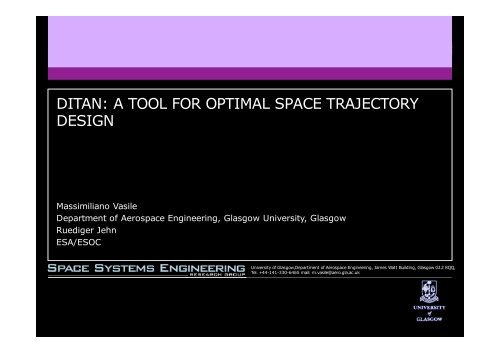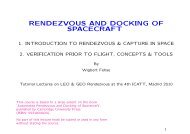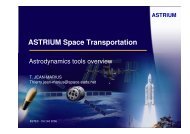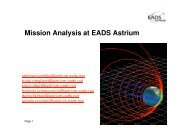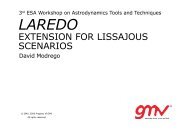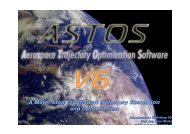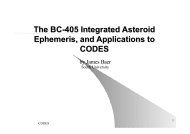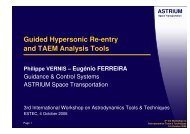DITAN: A TOOL FOR OPTIMAL SPACE TRAJECTORY DESIGN - ESA
DITAN: A TOOL FOR OPTIMAL SPACE TRAJECTORY DESIGN - ESA
DITAN: A TOOL FOR OPTIMAL SPACE TRAJECTORY DESIGN - ESA
- No tags were found...
You also want an ePaper? Increase the reach of your titles
YUMPU automatically turns print PDFs into web optimized ePapers that Google loves.
IntroductionStudy CasesWhat’s new?Final Remarks<strong>DITAN</strong>: A <strong>TOOL</strong> <strong>FOR</strong> <strong>OPTIMAL</strong> <strong>SPACE</strong> <strong>TRAJECTORY</strong><strong>DESIGN</strong>Massimiliano VasileDepartment of Aerospace Engineering, Glasgow University, GlasgowRuediger Jehn<strong>ESA</strong>/ESOCUniversity of Glasgow,Department of Aerospace Engineering, James Watt Building, Glasgow G12 8QQ,Tel. +44-141-330-6465 mail: m.vasile@aero.gla.ac.uk
IntroductionStudy CasesWhat’s new?Final RemarksIntroductionto <strong>DITAN</strong>Study Cases What’s new? FinalRemarksUniversity of Glasgow,Department of Aerospace Engineering, James Watt Building, Glasgow G12 8QQ,Tel. +44-141-330-6465 mail: m.vasile@aero.gla.ac.ukAgendaOutline
IntroductionStudy CasesWhat’s new?Final Remarks•<strong>DITAN</strong> (direct Interplanetary Trajectory Analysis) is a general purpose tool forthe solution of optimal control problems.•It implements a Direct Finite Elements Transcription (DFET) of the optimalcontrol problem into a nonlinear programming problem (NLP)•The solution of the resulting NLP is performed by the sparse SQP optimiserSNOPT•The specific optimal control problem implemented in <strong>DITAN</strong> allows to designlow-thrust multiple gravity assist trajectories.University of Glasgow,Department of Aerospace Engineering, James Watt Building, Glasgow G12 8QQ,Tel. +44-141-330-6465 mail: m.vasile@aero.gla.ac.ukIntroduction to <strong>DITAN</strong>
IntroductionStudy CasesWhat’s new?Final Remarks• Developed under <strong>ESA</strong>/ESOC contract for low-thrust multiple gravity assisttrajectories• Open system for general trajectory design based on Direct Finite ElementTranscription (DFET) and SSQP• Fortran 77 code has SNOPT (source code) as NLP engine• Several dynamic models, constraints and objectives can be implemented• Automatic mesh grid adaptivity is includedUniversity of Glasgow,Department of Aerospace Engineering, James Watt Building, Glasgow G12 8QQ,Tel. +44-141-330-6465 mail: m.vasile@aero.gla.ac.ukIntroduction to <strong>DITAN</strong>
IntroductionStudy CasesWhat’s new?Final Remarksusers/w coreDynamic ModelAlgebraicConstraintsDFETDiscretisationBoundary ConstraintsPhaseAssemblyexternalObjective FunctionNLP ProblemInputFirst GuessNLP SolverPost ProcessingOutputUniversity of Glasgow,Department of Aerospace Engineering, James Watt Building, Glasgow G12 8QQ,Tel. +44-141-330-6465 mail: m.vasile@aero.gla.ac.uk<strong>DITAN</strong>: Software Logic
IntroductionStudy CasesWhat’s new?Final RemarksxBoundaryNodesx bfGaussPointx bix sBoundary gapbtt st• The Time domain is decomposed in finite elements leading to a polynomialdevelopment of the solution on spectral basis (Gauss Points)DNiD ( t , t1 i i 1 i)University of Glasgow,Department of Aerospace Engineering, James Watt Building, Glasgow G12 8QQ,Tel. +44-141-330-6465 mail: m.vasile@aero.gla.ac.ukDirect Transcription by FET
IntroductionStudy CasesWhat’s new?Final RemarksxBoundaryNodesx bfGaussPointx bix sBoundary gapbt stt• Differential constraints are expressed in weak form leading to discontinuities at boundaries• High Integration order 2n = 2k+2t ft0wTx˙FdtwT( x xb)t ft0University of Glasgow,Department of Aerospace Engineering, James Watt Building, Glasgow G12 8QQ,Tel. +44-141-330-6465 mail: m.vasile@aero.gla.ac.ukDirect Transcription by FET
IntroductionStudy CasesWhat’s new?Final RemarksOptimal ControlProblemDFETNLP Problemmin J(y)c( y)0wherelc ( y)qi 1siG ( x (!sw˙(ik), uis)(Tixs),b y bluy=[x,u,t i,t f] T(ii))0wk(iT) F (si)t2jwTp1xbjwT1xbj10SSQPSparse SequentialQuadraticProgramminglUniversity of Glasgow,Department of Aerospace Engineering, James Watt Building, Glasgow G12 8QQ,Tel. +44-141-330-6465 mail: m.vasile@aero.gla.ac.ukDirect Transcription by FET
IntroductionStudy CasesWhat’s new?Final Remarks<strong>DITAN</strong> allows the inclusion of a general set of real parameters and related constraint andobjective functionst fb bJ ( x 0, xf, tf, p)L ( x,u,p)tidtminJ( y)ẋ F( x,u,p,t)G( x,u,p,t)00c(y)0bl y b u( xb0, xbf, p,t)t ft00y=[x s ,u s ,x b 0,x b f,t 0 ,t f ,p]University of Glasgow,Department of Aerospace Engineering, James Watt Building, Glasgow G12 8QQ,Tel. +44-141-330-6465 mail: m.vasile@aero.gla.ac.ukParametric Optimisation
IntroductionStudy CasesWhat’s new?Final Remarks<strong>DITAN</strong> allows the solution of problems with a finite number of discontinuities, multiplereference frames, multiple dynamic models and multiple objectives, through a multiphasedecomposition of the trajectory. Phases can be sequential or parallel.Phase lJ lẋGl( x,u,t)l( xlF ( x,u,t)( x,u,t)bi, xbf, p,t)t ft000Interphase-link Constraintsllinkl( x , xNLP Solverilf, tli, tlf)xtlixbb( t1li( tli1t1)lf)xbl( tlf( xb)( tlf))0AssemblyUniversity of Glasgow,Department of Aerospace Engineering, James Watt Building, Glasgow G12 8QQ,Tel. +44-141-330-6465 mail: m.vasile@aero.gla.ac.ukMultiphase Approach
IntroductionStudy CasesWhat’s new?Final Remarks• Multiple swing-by low-thrust Trajectories:– SOLO– Bepi Colombo– Europa– Mars Exobiology– Pluto Probe– NEO Rendezvous• Robustness Optimisation– Optimal NEO interception and deviation• Multiobjective and Pursuit-Evasion Problems• Mars free-return Trajectories• Moon WSB TransfersUniversity of Glasgow,Department of Aerospace Engineering, James Watt Building, Glasgow G12 8QQ,Tel. +44-141-330-6465 mail: m.vasile@aero.gla.ac.ukExamples of Applications
IntroductionStudy CasesWhat’s new?Final Remarks• 3000 variables andconstraints for theNLP problem• 4 to 7 swingbys• resonant orbits• more than 20switching pointsExample of Matlab output for a BepiColombo TrajectoryUniversity of Glasgow,Department of Aerospace Engineering, James Watt Building, Glasgow G12 8QQ,Tel. +44-141-330-6465 mail: m.vasile@aero.gla.ac.ukSOLO and BepiColombo
IntroductionStudy CasesWhat’s new?Final Remarks• 6000-7000 variablesand constraints forthe NLP problem• 14 swingbys• resonant orbits• variable thrust• Variable referenceframesUniversity of Glasgow,Department of Aerospace Engineering, James Watt Building, Glasgow G12 8QQ,Tel. +44-141-330-6465 mail: m.vasile@aero.gla.ac.ukEuropa
IntroductionStudy CasesWhat’s new?Final Remarks• 1000-7000variables andconstraints for theNLP problem• parallel phases• multiple objectives• Multiple swingbysUniversity of Glasgow,Department of Aerospace Engineering, James Watt Building, Glasgow G12 8QQ,Tel. +44-141-330-6465 mail: m.vasile@aero.gla.ac.ukPluto ProbeTwo Interplanetary parallel phases trajectory at Jupiter passage
IntroductionStudy CasesWhat’s new?Final Remarks• 1000-3000 variables adconstraints.• Variable thrust and variable I sp• Mean orbital elements formultispiral escape from the EarthUniversity of Glasgow,Department of Aerospace Engineering, James Watt Building, Glasgow G12 8QQ,Tel. +44-141-330-6465 mail: m.vasile@aero.gla.ac.ukNEO Rendezvous
IntroductionStudy CasesWhat’s new?Final Remarks• 1000-2000 variablesand constraints• multiple objectives• minimisation of theuncertainties and ofthe expected valueof the objectiveUniversity of Glasgow,Department of Aerospace Engineering, James Watt Building, Glasgow G12 8QQ,Tel. +44-141-330-6465 mail: m.vasile@aero.gla.ac.ukRobustness Optimisation
IntroductionStudy CasesWhat’s new?Final Remarks• Zero-sum differentialgame• Multiple objectives• Reconstruction of thecorrect lagrangianmultipliers of theoptimal controlproblemMultiobjective and Pursuit-EvasionProblemsUniversity of Glasgow,Department of Aerospace Engineering, James Watt Building, Glasgow G12 8QQ,Tel. +44-141-330-6465 mail: m.vasile@aero.gla.ac.uk
IntroductionStudy CasesWhat’s new?Final Remarks• 200-4000variables andconstraints• 1-14 swingbys• Impulsive andlow-thrustMars free-return Trajectories and LowthrustCyclersUniversity of Glasgow,Department of Aerospace Engineering, James Watt Building, Glasgow G12 8QQ,Tel. +44-141-330-6465 mail: m.vasile@aero.gla.ac.uk
IntroductionStudy CasesWhat’s new?Final Remarks• 1000-1500variables andconstraints• Highly nonlinearand unstabledynamics• ImpulsivemanoeuvresUniversity of Glasgow,Department of Aerospace Engineering, James Watt Building, Glasgow G12 8QQ,Tel. +44-141-330-6465 mail: m.vasile@aero.gla.ac.ukMoon WSB Transfers
IntroductionStudy CasesWhat’s new?Final RemarksNew features:Improved user interface: easier editing of the input filesNew graphical user interface for trajectoryrepresentationTransfer coast arcs can be analytically propagated: fastersolution of MGA with chemical propulsionTransfer arcs can be imported and editedUniversity of Glasgow,Department of Aerospace Engineering, James Watt Building, Glasgow G12 8QQ,Tel. +44-141-330-6465 mail: m.vasile@aero.gla.ac.ukNew Features
IntroductionStudy CasesWhat’s new?Final RemarksNew features:Extended database of celestial bodies: asteroids and cometsdatabase, updatableNew sets of boundary conditions: numerically or analyticallypropagated orbitsNew set of objective functions: orbit insertion v with gravitylosses, staging.Atmospheric legs: aerocaptureRestricted three-body dynamicsUniversity of Glasgow,Department of Aerospace Engineering, James Watt Building, Glasgow G12 8QQ,Tel. +44-141-330-6465 mail: m.vasile@aero.gla.ac.ukNew Features
IntroductionStudy CasesWhat’s new?Final Remarks<strong>DITAN</strong> has been effectively applied to the solution of manymission design problems.A limitation exists on the maximum dimension of the problems thatcan be solved.An improved NLP solver is required and it is under development atpresentSince many problems have a hybrid structure (mixed integer-realvariables) the new NLP is conceived to tackle hybrid problems.University of Glasgow,Department of Aerospace Engineering, James Watt Building, Glasgow G12 8QQ,Tel. +44-141-330-6465 mail: m.vasile@aero.gla.ac.ukFinal Remarks


